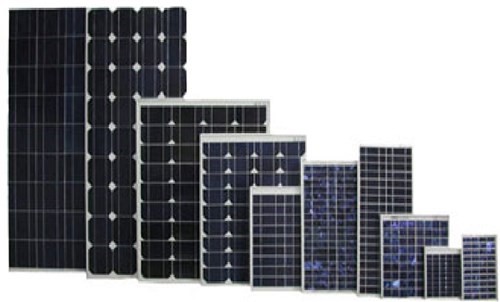Solar Panels/Modules
Solar PV Module (MONO/POLY) 3 Watt to 350 Watt

Solar PhotoVoltaic (PV) Technology
The variety of solar power technologies available are compared on a scale of efficiency, price, durability, and flexibility, depending upon the need of your project. PV solar technology generates power because substances like silicon generate an electrical current when they absorb sunlight, in a process known as the photovoltaic effect. Like semiconductors, solar PV technology needs purified silicon to get the best efficiency, and the price behind PV solar manufacturing is often driven by the crystalline silicon purification process. Bright Solar offers a range of Solar PV Modules with power ratings from 3 Watts to 350 Watts of Mono- and Poly-crystalline Silicon varieties. Here's a quick look at both of these technologies.
Monocrystalline Silicon Solar PV: Most Efficient
Generally, monocrystalline silicon solar PV is the best technology to deliver efficiency, as measured by wattage output related to the panel’s size. But this efficiency can come with costs. The best value is solar PV technology is polycrystalline silicon, offering efficiency levels close to monocrystalline panels, but at half the costs in some cases.
Monocrystalline solar is made by growing a single crystal. Because these crystals are usually an oval shape, monocrystalline panels are cut into the distinctive patterns that give them their recognizable appearance: the sliced silicon cells expose the missing corners in the grid-like structure. The crystal framework in a monocrystalline is even, producing a steady blue color and no grain marks, giving it the best purity and highest efficiency levels.
Polycrystalline Silicon Solar PV: Best Value
Polycrystalline solar is made by pouring molten silicon into a cast. However, because of this construction method, the crystal structure will form imperfectly, creating boundaries where the crystal formation breaks. This gives the polycrystalline silicon its distinctive, grainy appearance, as the gemstone type pattern highlights the boundaries of the crystal.
Because of these impurities in the crystal, polycrystalline silicon is less efficient when compared with monocrystalline. However, this manufacturing process uses less energy and materials, giving it a significant cost advantage over monocrystalline silicon. (Polycrystalline and multicrystalline are often synonyms, but multicrystalline is often meant to refer to silicon with crystallites larger than 1 mm.)
demo
demo
fdemo
